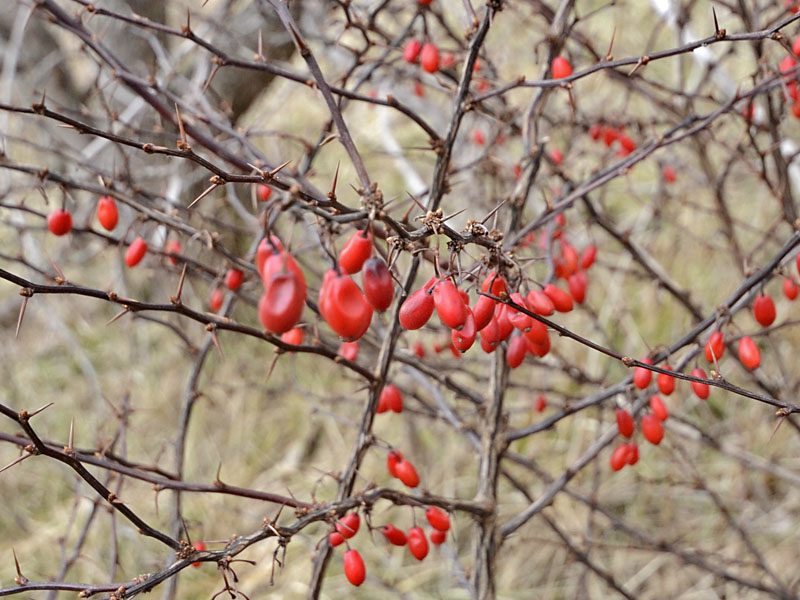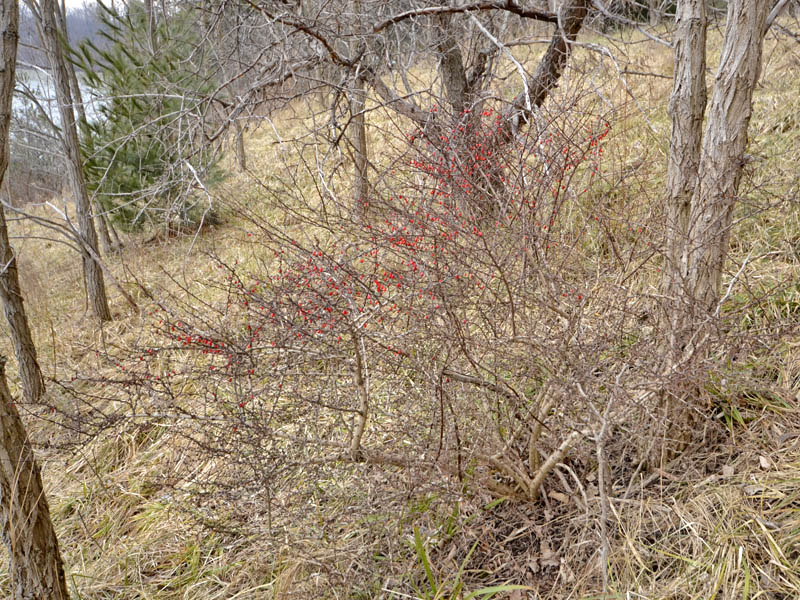| General Description | A few-stemmed deciduous shrub with rhizomes that root into the ground and form a ground cover suitable for soil erosion control. |
| ID Characteristic | This plant has very distinct red berries, large thorny spikes that cover the stems and dark green glabrous leaves that persist through the seasons. |
| Shape | Low growing, sparsely stemmed shrub. |
| Landscape | B. canadensis is a hardy shrub often used in commercial landscape as a ground cover or massing. It has nice fruit, flower, and foliage but it is overall not very pleasing to the eye. This plant is becoming a rarity in the landscape and is hard to find. Its berries are edible and have a variety of uses as they are palatable and contain high amounts of vitamin C. |
| Propagation | American Barberry should be propagated as a seed in a cold frame. Seeds should be sown as soon as they are ripe and will typically germinate in late winter or early spring. If seed is over-ripe it will take longer to germinate. The seedlings should be kept in a well-ventilated area as they are prone to damping off. Seedlings can be placed in individual containers once they have grown to a suitable size to be handled and should continue to grow in a cold frame. It is possible to move seedlings to their permanent positions in the autumn, however, it is typically best to wait leave them in the cold frame through winter and plant them in late spring or early summer of the next year. Semi-hard and hard wood cuttings (preferably with a heel) are suitable means of propagation as well, given they are grown in a cold frame. |
| Cultivation | American Barberry can grow in a variety of conditions but prefers well-drained, loamy, thin soils of basic, neutral, or slightly acidic pH. Grows best in full sun to partial shade but can tolerate a variety of exposures given adequate moisture. Should be pruned back to 10-15 cm regularly to maintain and rejuvenate. |
| Pests | Few pest and disease problems. However, as with many of the barberry species, it can be susceptible to black stem rust. |
| Notable Specimens | Wildwood Park, Radford, Virginia, United States of America. |
| Habitat | Typically found over bedrock or were seasonally wet soils are found. It has been known to grow on open, exposed hillside slopes, rocky woods, bluffs, creek banks, and roadsides with little pH specifics. |
| Bark/Stem Description | The bark of this plant is ridged and dull brown with large spikes that tend to curve downward protruding in threes. Each thorn is about 1-1.5 cm long. |
| Flower/Leaf Bud Description | The buds of this plant are the same colour as the bark and quite small (1.5-3.5 mm), making them fairly un-noticeable and not noteworthy. |
| Leaf Description | Leaves are dark, glossy green, obovate, 2-6 cm long, with up to 20 teeth per margin. The leaves change to a dull yellow then brown in the autumn and drop very late in the season. |
| Flower Description | The flowers of B. canadensis are in a raceme formation 2-5 cm long and have 3-12 flowers. Each flower has six stamens and six petals that are yellow to pale-yellow, cupped-shaped and notched at the tips. They are about 2.5-3.5 mm long. Each flower is arranged in a pattern similar to a double row with each petal sitting on top of the next. It has a stigma in the middle that is a bright green colour. |
| Fruit Description | The fruits of are fleshy, ovoid, 5-7 mm long, red berries. Each fruit contains anywhere from 1-10 seeds. They are edible with a tart-like taste and high in vitamin C. |
| Colour Description | The most significant colour of B. canadensis is its bright red fruit which persists through the autumn into winter. It has quite attractive deep green foliage and fairly un-noticeable dull brown bark. The flowers of this plant are a nice pale butter-cup yellow with a bright green stigma in the centre. |
| Texture Description | Coarse texture that persists throughout the seasons. |

